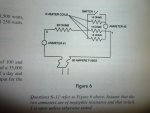Question 6. The equivalent resistance of the 3 heater coils connected as shown is: Answer 5 ohms.
Question 7. If ammeter 2 reads 6 amps, ammeter 1 will read: Answer 18 amps.
I don't understand how they got this answer. Could someone explain this please. Thank you for your help.
Question 7. If ammeter 2 reads 6 amps, ammeter 1 will read: Answer 18 amps.
I don't understand how they got this answer. Could someone explain this please. Thank you for your help.

